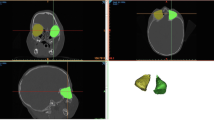Abstract
The potential of CT to facilitate preoperative planning of reconstructive maxillofacial surgery by orbital volume quantification was analysed in 11 patients with traumatic enophthalmos as a late sequela of zygomatic fractures. We carried out biplanar CT examination of the orbits, and calculated total orbital and fat volumes for the healthy and enophthalmic sides. Displacement of the orbital floor and lateral wall was present in 11 and 7 cases respectively. Indentation of the medial wall was noted in 9 cases. Quantitative evaluation of the orbital cavity revealed a significant increase (P<0.0188) in total volume on the enophthalmic side, the difference between the two sides ranging from 9.2% to 36.4%, mean 17.9%. The degree of enophthalmos, measured radiologically as 2.5–5 mm, correlated with the increase in orbital cavity volume (P=0.000076). Enophthalmos was 2.5–3 mm in 7 cases (63.6%) and 3.5–5 mm in 4 (36.4%). This corresponded with a mean increase in orbital volume of 3.4 ml (12.3%) and 7.1 ml (27.8%) respectively. Fat atrophy was not an aetiological factor in the production of post-traumatic enophthalmos.
Similar content being viewed by others
References
Pearl RM (1992) Treatment of enophthalmos. Clin Plast Surg 19:99–111
Bogren HG, Franti CE, Wilmarth SS (1986) Normal variations of the eye in the rbit. Ophthalmology 93:1072–1077
McGurk M, Whitehouse RW, Taylor PM, Swinson B (1992) Orbital volume measured by a low-dose CT scanning technique. Radiology 21:70–72
Forbes G, Gehring DG, Gorman CA, Brennan MD, Jackson IT (1985) Volume measurements of normal orbital structures by computed tomographic analysis. AJNR 6:419–424
Forbes G, Gorman CA, Brennan MD, Gehring DG, Ilstrup DM, Earnest F (1986) Ophthalmopathy of Graves' discase: computerized volume measurements of the orbital fat and muscle. AJNR 7:651–656
Manson PN, Grivas A, Rosenbaum A, Vannier M, Zinreich J, Iliff N (1986) Studies on enophthalmos. II. The measurement of orbital injuries and their treatment by quantitative computed tomography. Plast Reconstr Surg 77:203–214
Bite U, Jackson IT, Forbes GS, Gehring DG (1985) Orbital volume measurements in enophthalmis using three-dimensional CT imaging. Plast Reconstr Surg 75:502–507
Lang W (1889) Injuries and disease of the orbit. Trans Ophthalmol Soc UK 9: 41–45
Smith B, Reagan WF (1957) Blow-out fracture of the orbit. Am J Ophthalmol 44:733–739
Fujino T (1974) Experimental “blow-out” fracture of the orbit. Plast Reconstr Surg 54:81–82
Jend HH, Jend-Rossmann I, Borchers D, Heller M (1982) Die Analyse der Gesichtsschädelfrakturen im CT. Fortschr Röntgenstr 137:379–383
Pfeiffer RL (1943) Traumatic enophthalmos. Arch Ophthalmol 30:718–726
Langen HJ, Daus HJ, Bohndorf K, Klose K (1989) Konventionelle Röntgenuntersuchung und Computertomographie bei der Diagnostik von Orbitafrakturen. Fortschr Röntgenstr 150: 582–587
Irnberger T (1985) Diagnostische Möglichkeiten und Wertigkeit der konventionellen Radiographie, Röntgentomographie und hochauflösenden Computertomographie beim komplexen orbitalen Trauma. Fortschr Röntgenstr 142: 146–154
Hammerschlag SB, Hughes S, O'Reilly GV, Weber AL (1982) Another look at blow-out fractures of the orbit. AJNR 139:133–137
Hammerschlag SB, Hughes S, O'Reilly GV, Naheedy MH, Rumbaugh CL (1982) Blow-out fractures of the orbit: a comparison of computed tomography and conventional radiography with anatomical correlation. Radiology 143: 487–492
Zilkha A (1981) Computed tomography of blow-out fracture of the medial orbital wall. AJR 137:963–965
Manson PN, Clifford CM, Iliff NT, Morgan R (1986) Mechanisms of global support and posttraumatic enophthalmos. I. The anatomy of the ligament sling and its relation to intramuscular cone orbital fat. Plast Reconstr Surg 77: 193–202
Zouaoui A, Metzger J, Princ G, Grob R, García Cervigón E, Arzimanoglou A, Acher B, Boukobza M, Vaillant JM (1986) La tomodensitomètrie dans les traumatismes orbito-frontaux. J Neuroradiol 13:291–304
Carls FR, Schuknecht B, Sailer HF (1994) Die Orbitavolumetrie als Planungsgrundlage vor Orbitawandrekonstruktion. Fortschr Kiefer Gesichtschir 39:23–27
Parsons GS, Mathog RH (1988) Orbital wall and volume relationship. Arch Otolaryngol Head Neck Surg 114:743–746
Charteris DG, Chan CH, Whitehouse RW, Noble JL (1993) Orbital volume measurement in the management of pure blowout fractures of the orbital floor. Br J Ophthalmol 77:100–102
Author information
Authors and Affiliations
Rights and permissions
About this article
Cite this article
Schuknecht, B., Carls, F., Valavanis, A. et al. CT assessment of orbital volume in late post-traumatic enophthalmos. Neuroradiology 38, 470–475 (1996). https://doi.org/10.1007/BF00607281
Received:
Accepted:
Issue Date:
DOI: https://doi.org/10.1007/BF00607281




